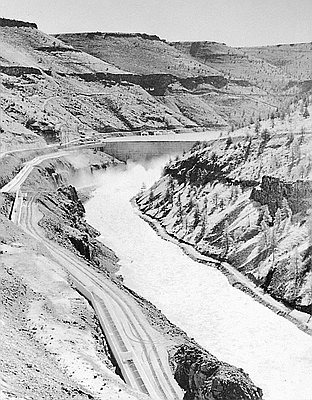As early as 1902, the Oregon State Fish Commission established an experimental hatchery station on the Coquille River, near Bandon on the southern Oregon Coast. In 1910, the commission leased property adjacent to the river and constructed a simple hatchery building. The commission had also recently established six other hatcheries for salmon and steelhead on Oregons coastal rivers and the Columbia River, including the Bonneville Central Hatchery built in 1909. The building in this picture may be from a later date, and possibly a different location than the first Coquille River hatchery.
Early fishery officials believed that it would be more effective to artificially propagate salmon rather than to attempt to protect streams from destructive human uses and alterations, such as logging and dams. Hatchery workers barricaded streams with wooden racks, stopping salmon from reaching their native spawning grounds. They then captured the fish gathered near the barricades, and removed their eggs and milt. Workers fertilized and incubated the eggs and later released young fry into streams and rivers throughout Oregon.
The early hatchery program in Oregon was largely unsuccessful because managers did not understand salmon life cycles. By transplanting fry to non-natal streams they disrupted thousands of years of evolution that had adapted salmon to different conditions. In addition, until the 1910s, hatchery workers released fry too early, when they were more vulnerable to predators. It was not until the 1930s that more scientific efforts were made to study salmon and make changes to the hatchery system. However, the success of hatcheries continues to be debated. During the last fifty years, coho and spring chinook salmon and steelhead and sea-run cutthroat trout have declined in the Coquille River.
Further Reading:
Taylor, Joseph E., III. Making Salmon: An Environmental History of the Northwest Fisheries Crisis. Seattle, Wash., 1999.
Cone, Joseph and Sandy Ridlington, ed. The Northwest Salmon Crisis: A Documentary History. Corvallis, Oreg., 1996.
Written by Kathy Tucker, © Oregon Historical Society, 2002.



